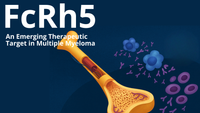TM4SF1 in Cancer Immunotherapy: Emerging Research and Clinical Potential
By Mallory Griffin
TM4SF1 (Transmembrane 4L six family member 1) is a member of the TM4SF subfamily in the Tetraspanin superfamily. It was first identified in 1986. It has a typical four-transmembrane structure of the Tetraspanin family and contains two extracellular loop regions EC1 and EC2 (Figure 1). The C-terminal cytoplasmic region contains a PDZ-binding domain that can interact with syntenin-1 and syntenin-2 proteins to mediate tumorigenesis, cell proliferation, and metastasis. The EC2 region can bind to integrin α5β1 through a cysteine residue, affecting cell adhesion and movement [1]. The C-terminal cytoplasmic region contains a PDZ-binding domain, which can interact with syntenin-1 and syntenin-2 proteins to mediate proliferation and metastasis of tumor cells.

Figure 1. TM4SF1 structure [1].
TM4SF1 is highly expressed on the surface of lung cancer, breast cancer [2], liver cancer, colorectal cancer and ovarian cancer cells, and can form complexes with lipid kinases, tyrosine protein kinases, etc. For example, it can bind to DDR1, activate PKC and JAK2-STAT3 signaling pathways, and promote cell pseudopodia extension [3]. In addition to being involved in cell proliferation and motility, TM4SF1 also mediates tumor cell EMT transformation [4] and angiogenesis [5]. It is also involved in regulating the self-renewal of tumor stem cells [6], and is associated with tumor drug resistance and poor prognosis. Thus, it is a potential anti-tumor target.

Figure 2. TM4SF1 mediates downstream signaling pathways by binding to DDR1 or integrins [7].
The clinical drug disclosure of TM4SF1 is minimal, and most of them are in the research stage. Since TM4SF1 is highly expressed on the surface of tumor cells and tumor endothelial cells, it is a favorable target for the development of antibody drugs. In terms of monoclonal antibody drugs, there is mAb-L6 [8], L6-Ag (chL6), and the ADC (antibody-drug conjugate), 2A7A-LP2 [9]. There are also CAR-T drugs targeting TM4SF1, such as the clinical trials conducted by Tangdu Hospital of Fourth Military Medical University for patients with relapsed and refractory solid tumors positive for TM4SF1 and EpCAM. In addition, due to their advantages in safety and flexibility, epitope peptides are also a new therapeutic direction for TM4SF1. Some studies have found that HLA-A2-restricted TM4SF1 epitope peptide, Peptide 5 (LLMLLPAFV), can induce T cell immunity after immunization. The reaction leads to an increase in the number of cytotoxic T cells in the body, which in turn inhibits the growth of TM4SF1-positive tumor cells [10]. Similarly, the epitope peptide EP1 was found to recognize B cells [11]. In addition, in the field of stem cell research, it has been reported that TM4SF1-positive cells in the lung can regenerate damaged bronchial and alveolar tissues [12], which provides important clues for the current stem cell therapy for severe new coronary pneumonia.
The competition for new drug research and development is increasingly fierce, and the search for new drug targets may be the key to breaking through. Through its proprietary protein discovery and production technology platform, KACTUS has launched a full-length TM4SF1 protein with highly active VLP display, which has strong immunogenicity and facilitates the development of TM4SF1-related drugs.
Product Data

ELISA experiments verified that VLPs displayed full-length TM4SF1 protein that could effectively bind to anti-TM4SF1 antibodies, with an EC50 value of 8.8 ng/mL.

DDR1 protein has been verified by ELISA experiment, and it can efficiently bind to DDR1 antibody, and the EC50 value is 12.8ng/mL.
KACTUS Products
|
Catalog # |
Description |
|
Human TM4SF1 VLP |
|
|
Human DDR1, His Tag |
|
|
Mouse DDR1, His Tag |
|
|
Human ITGA5&ITGB1, His-Avi Tag |
|
|
Biotinylated Human ITGA5&ITGB1, His-Avi Tag |
References
[1] Fu F, Yang X, Zheng M, Zhao Q, Zhang K, Li Z, Zhang H, Zhang S. Role of Transmembrane 4 L Six Family 1 in the Development and Progression of Cancer. Front Mol Biosci. 2020 Aug 18;7:202. doi: 10.3389/fmolb.2020.00202. PMID: 33015133; PMCID: PMC7461813.
[2] Sun Y, Xu Y, Xu J, Lu D, Wang J. Role of TM4SF1 in regulating breast cancer cell migration and apoptosis through PI3K/AKT/mTOR pathway. Int J Clin Exp Pathol. 2015 Aug 1;8(8):9081-8. PMID: 26464650; PMCID: PMC4583882.
[3] Gao H, Chakraborty G, Zhang Z, Akalay I, Gadiya M, Gao Y, Sinha S, Hu J, Jiang C, Akram M, Brogi E, Leitinger B, Giancotti FG. Multi-organ Site Metastatic Reactivation Mediated by Non-canonical Discoidin Domain Receptor 1 Signaling. Cell. 2016 Jun 30;166(1):47-62. doi: 10.1016/j.cell.2016.06.009. PMID: 27368100; PMCID: PMC4980842.
[4] Lee JY, Kong G. Roles and epigenetic regulation of epithelial-mesenchymal transition and its transcription factors in cancer initiation and progression. Cell Mol Life Sci. 2016 Dec;73(24):4643-4660. doi: 10.1007/s00018-016-2313-z. Epub 2016 Jul 26. PMID: 27460000.
[5] Shih SC, Zukauskas A, Li D, Liu G, Ang LH, Nagy JA, Brown LF, Dvorak HF. The L6 protein TM4SF1 is critical for endothelial cell function and tumor angiogenesis. Cancer Res. 2009 Apr 15;69(8):3272-7. doi: 10.1158/0008-5472.CAN-08-4886. Epub 2009 Apr 7. PMID: 19351819; PMCID: PMC2774109.
[6] Bae S, Shim SH, Park CW, Son HK, Lee HJ, Son JY, Jeon C, Kim H. Combined omics analysis identifies transmembrane 4 L6 family member 1 as a surface protein marker specific to human mesenchymal stem cells. Stem Cells Dev. 2011 Feb;20(2):197-203. doi: 10.1089/scd.2010.0127. Epub 2010 Nov 1. PMID: 20486778.
[7] Gao H, Chakraborty G, Zhang Z, Akalay I, Gadiya M, Gao Y, Sinha S, Hu J, Jiang C, Akram M, Brogi E, Leitinger B, Giancotti FG. Multi-organ Site Metastatic Reactivation Mediated by Non-canonical Discoidin Domain Receptor 1 Signaling. Cell. 2016 Jun 30;166(1):47-62. doi: 10.1016/j.cell.2016.06.009. PMID: 27368100; PMCID: PMC4980842.
[8] Goodman GE, Hellström I, Brodzinsky L, Nicaise C, Kulander B, Hummel D, Hellström KE. Phase I trial of murine monoclonal antibody L6 in breast, colon, ovarian, and lung cancer. J Clin Oncol. 1990 Jun;8(6):1083-92. doi: 10.1200/JCO.1990.8.6.1083. PMID: 2161448.
[9] Visintin A, Knowlton K, Tyminski E, Lin CI, Zheng X, Marquette K, Jain S, Tchistiakova L, Li D, O'Donnell CJ, Maderna A, Cao X, Dunn R, Snyder WB, Abraham AK, Leal M, Shetty S, Barry A, Zawel L, Coyle AJ, Dvorak HF, Jaminet SC. Novel Anti-TM4SF1 Antibody-Drug Conjugates with Activity against Tumor Cells and Tumor Vasculature. Mol Cancer Ther. 2015 Aug;14(8):1868-76. doi: 10.1158/1535-7163.MCT-15-0188. Epub 2015 Jun 18. PMID: 26089370.
[10] Tu SH, Huang HI, Lin SI, Liu HY, Sher YP, Chiang SK, Chong P, Roffler S, Tseng GC, Chen HW, Liu SJ. A novel HLA-A2-restricted CTL epitope of tumor-associated antigen L6 can inhibit tumor growth in vivo. J Immunother. 2012 Apr;35(3):235-44. doi: 10.1097/CJI.0b013e318248f2ae. PMID: 22421941.
[11] Lin SI, Huang MH, Chang YW, Chen IH, Roffler S, Chen BM, Sher YP, Liu SJ. Chimeric peptide containing both B and T cells epitope of tumor-associated antigen L6 enhances anti-tumor effects in HLA-A2 transgenic mice. Cancer Lett. 2016 Jul 28;377(2):126-33. doi: 10.1016/j.canlet.2016.04.031. Epub 2016 Apr 26. PMID: 27130449.
[12] Zacharias WJ, Frank DB, Zepp JA, Morley MP, Alkhaleel FA, Kong J, Zhou S, Cantu E, Morrisey EE. Regeneration of the lung alveolus by an evolutionarily conserved epithelial progenitor. Nature. 2018 Mar 8;555(7695):251-255. doi: 10.1038/nature25786. Epub 2018 Feb 28. PMID: 29489752; PMCID: PMC6020060.















